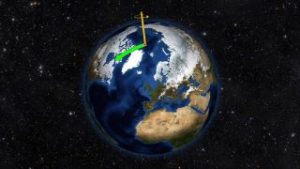Climate Change Causing Shift In Earth’s Axis:

A study published in Geophysical Research Letters of the American Geophysical Union (AGU) says that due to the significant melting of glaciers because of global temperature rise, Earth’s axis of rotation has been moving more than usual since the 1990s.
- While this change is not expected to affect daily life, it can change the length of the day by a few milliseconds.
Findings from the New Study:
- Since the 1990s, climate change has caused billions of tonnes of glacial ice to melt into oceans. This has caused the Earth’s poles to move in new directions.
- The north pole has shifted in a new eastward direction since the 1990s, because of changes in the hydrosphere (meaning the way in which water is stored on Earth).
- From 1995 to 2020, the average speed of drift was 17 times faster than from 1981 to 1995.
- Also, in the last four decades, the poles moved by about 4 metres in distance.
- The calculations were based on satellite data from NASA’s Gravity Recovery and Climate Experiment (GRACE) mission.
Causes of Polar Drift:
- Ice Melting:
- Change in Non-Glacial Regions (Terrestrial Water Storage):
- Groundwater Depletion:




